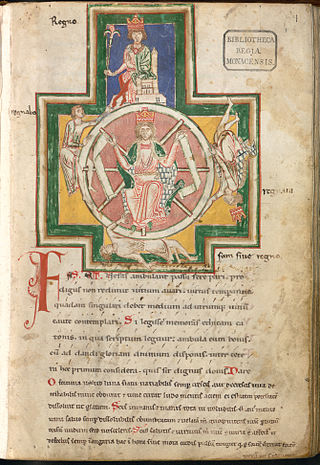
Carmina Burana is a manuscript of 254 poems and dramatic texts mostly from the 11th or 12th century, although some are from the 13th century. The pieces are mostly bawdy, irreverent, and satirical. They were written principally in Medieval Latin, a few in Middle High German and old Arpitan. Some are macaronic, a mixture of Latin and German or French vernacular.

Ferdinand Gregorovius was a German historian who specialized in the medieval history of Rome.
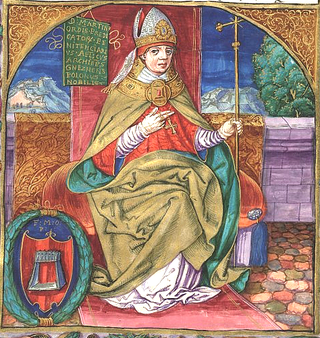
Martin of Opava, O.P. also known as Martin of Poland, was a 13th-century Dominican friar, bishop and chronicler.
Ulrich Willerding is a professor emeritus of botany at the Göttingen University, Germany. He is also an instructor at a local high school. Willerding is one of the leading European palaeo-ethnobotanists. He has specialized in Medieval Europe but also done work on other times. One of his special interests is weeds. He has worked on bibliographies of European paleoethnobotany. Although a biologist by training, he has worked extensively with archaeologists.

Hilduin was Bishop of Paris, chaplain to Louis I, reforming Abbot of the Abbey of Saint-Denis, and author. He was one of the leading scholars and administrators of the Carolingian Empire.
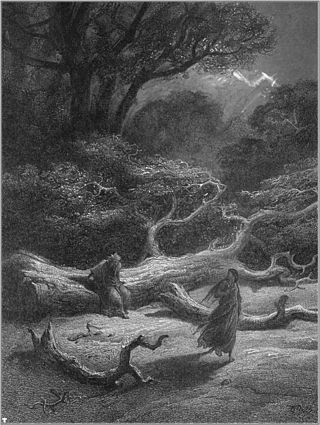
Brocéliande, earlier known as Brécheliant and Brécilien, is a legendary enchanted forest that had a reputation in the medieval European imagination as a place of magic and mystery. Brocéliande is featured in several medieval texts, mostly related to the Arthurian legend and the characters of Merlin, Morgan le Fay, the Lady of the Lake, and some of the Knights of the Round Table. It first appeared in literature in the Roman de Rou chronicle by Wace in 1160 and today is most commonly identified as Paimpont forest in Brittany, France.

Geoffrey IV de la Tour Landry was a nobleman of Anjou who fought in the Hundred Years War.
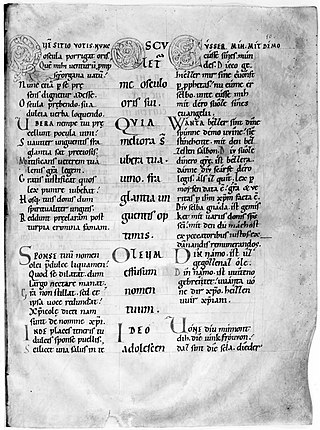
Williram of Ebersberg was a Benedictine Abbot. He is best known for his 'Expositio in Cantica Canticorum', a complex commentary of the Song of Songs which includes an Old High German translation and a Latin verse paraphrase.
Erenfried II was a Lotharingian nobleman, from the area of Bonn in what is now Germany. According to one proposal, he was a son of Eberhard I, Count of Bonngau and Zülpichgau. He could otherwise be the same as Ehrenfrid, son of Ricfrid.
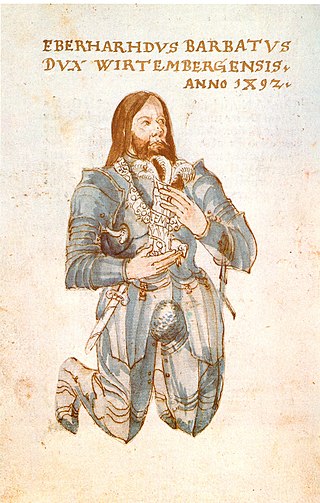
Eberhard I of Württemberg was known as Count Eberhard V from 1459 to 1495, and from July 1495 he was the first Duke of Württemberg. He is also known as Eberhard im Bart.

Eleanor of Scotland was an Archduchess of Austria by marriage to Sigismund, Archduke of Austria, a noted translator, and regent of Austria in 1455-58 and 1467. She was a daughter of James I of Scotland and Joan Beaufort.

Erich Hackl is an Austrian novelist and short story writer. His works have been translated into English, Spanish, French, Czech and Hebrew though he is significantly better known in the German-speaking world. Many of his works, notably Sara und Simón, bear resemblance to Latin-American testimonial literature, and as such have been the focus of scholarly research by Latin Americanists.
Guy XIV de Laval, François de Montfort-Laval,, comte de Laval, baron de Vitré and of La Roche-Bernard, seigneur of Gâvre, of Acquigny, of Tinténiac, of Montfort and Gaël, of Bécherel, was a French nobleman, known for his account of Joan of Arc. He and his brother André de Lohéac were simultaneously vassals of the duke of Brittany and of the king of France.

Rudolf Simek is an Austrian philologist and religious studies scholar who is Professor and Chair of Ancient German and Nordic Studies at the University of Bonn. Simek specializes in Germanic studies, and is the author of several notable works on Germanic religion and mythology, Germanic peoples, Vikings, Old Norse literature, and the culture of Medieval Europe.

Ernst Ludwig was duke of Pomerania from 1560 to 1592. From 1569 to 1592, he was duke in the Teilherzogtum Pomerania-Wolgast, sharing the rule over the Duchy of Pomerania with his older brother Johann Friedrich, duke in the other Teilherzogtum Pomerania-Stettin and bishop of Cammin.
The Jüngere Hochmeisterchronik, Croniken van der Duytscher Oirden, or Utrecht Chronicle of the Teutonic Order is a Middle Dutch chronicle of the Teutonic Order. It was written in or around the city of Utrecht in the Low Countries in several phases: around 1480, around 1491, and with some minor alterations after 1492. It has been referred to as “the final piece of the puzzle that is the official historiographic tradition of the Teutonic Order”. The anonymous chronicle was likely authored by the land commander of the Utrecht bailiwick of the Teutonic Order, Johan van Drongelen, in cooperation with his personal secretary Hendrik Gerardsz. van Vianen.
Heinz Schilling is a German historian.

Julia Voss is a German journalist and scientific historian. She is a writer and art critic who works at the Frankfurter Allgemeine Zeitung.

Raetia Curiensis was an early medieval province in Central Europe, named after the preceding Roman province of Raetia prima which retained its Romansh culture during the Migration Period, while the adjacent territories in the north were largely settled by Alemannic tribes. The administrative capital was Chur in the present Swiss canton of Grisons.
The House of Limburg was a dynasty which can be traced back in the male line as far as Henry, count of Limburg, whose mother Jutta was heiress of Frederick, Duke of Lower Lorraine in the House of Ardenne–Luxembourg. Henry was also related to the counts of Arlon. Waleran I was probably his father-in-law rather than his father.














